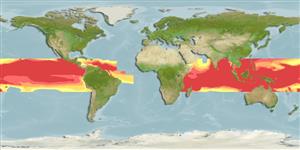Common names from other countries
Issue
Issue on validity of subspecies: subspecies considered as valid in FB, elevated to species rank as Oxyporhamphus micropterus (Valenciennes, 1847) in Eschmeyer (CofF ver. Mar. 2011: Ref. 86697). Please send references, or more studies are needed.
Environment: milieu / climate zone / depth range / distribution range
Ecologie
marien; oceanodroom (Ref. 51243); diepte 0 - 1 m (Ref. 58302). Tropical; 20°N - 20°S
Indo-Pacific: East Africa to Tonga, north to southern Japan (Ref. 33390). Eastern Pacific: Mexico to Peru (Ref. 9306). Replaced in the Atlantic by Oxyporhamphus similis.
Lengte bij maturiteit / Grootte / Gewicht / Leeftijd
Maturity: Lm 12.8, range 13 - 13 cm
Max length : 18.5 cm SL mannelijk / geslacht onbekend; (Ref. 9843)
Dorsale stekels (totaal) : 0; Dorsale zachte stralen (totaal) : 13 - 15; Anale stekels: 0; Anale zachte stralen: 13 - 16; Wervels: 47 - 50. Adults with a single large chamber to the swim bladder. Average number of gill rakers on the first arch, 30.7; predorsal scales, 31.1 on the average. Branchiostegal rays: 11-14 (Ref. 36576).
A true oceanic species, not bound to coastal waters at any period of its life (Ref. 9843).This species is the only halfbeak which doesn't have an extended lower jaw at the adult phase (Ref. 9306). Oviparous, with planktonic eggs and larvae (Ref. 36576).
Collette, B.B., 1986. Hemiramphidae. p. 388-391. In M.M. Smith and P.C. Heemstra (eds.) Smiths' sea fishes. Springer-Verlag, Berlin. (Ref. 4164)
Status op de Rode Lijst van het IUCN (Ref. 130435)
CITES (Ref. 128078)
Not Evaluated
Gevaar voor de mens
Harmless
Gebruik door de mens
Tools
Speciale rapporten
Download XML
Internetbronnen
Estimates based on models
Preferred temperature (Ref.
115969): 26.3 - 29.2, mean 27.9 (based on 25608 cells).
Fylogenetische diversiteitsindex (Ref.
82804): PD
50 = 0.7500 [Uniqueness, from 0.5 = low to 2.0 = high].
Bayesian length-weight: a=0.00324 (0.00148 - 0.00710), b=3.08 (2.90 - 3.26), in cm Total Length, based on LWR estimates for this (Sub)family-body shape (Ref.
93245).
Trofisch niveau (Ref.
69278): 3.1 ±0.15 se; based on food items.
Weerstandsvermogen (Ref.
120179): Hoog, minimale populatieverdubbelingstijd minder dan 15 maanden (K=1.0).
Fishing Vulnerability (Ref.
59153): Low vulnerability (15 of 100).
